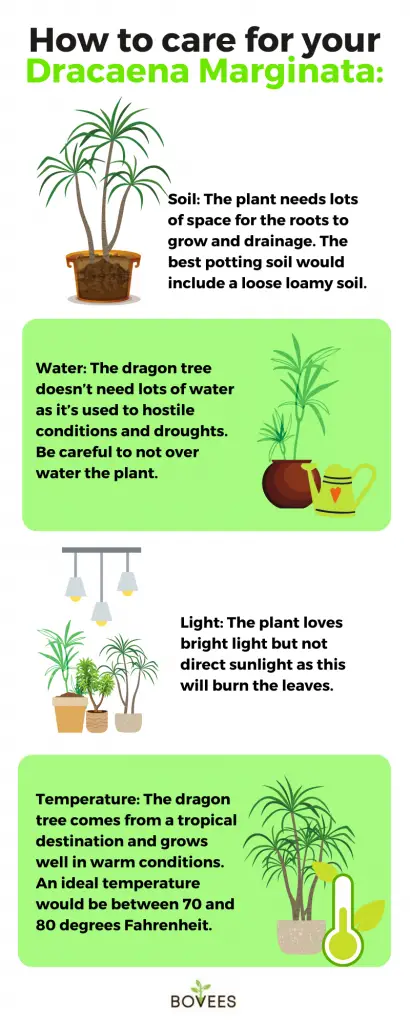Last Updated on January 13, 2022 by Grow with Bovees
Welcome to our Dracaena Marginata care guide.
The Dracaena marginata is more commonly known as a dragon tree. The origin of its name is from the ancient Greek word drakaina or “female dragon.”
The plant has a red resin in the stems, and this is likened to dragon blood.
All varietals in the dragon plant family are attractive plants with their dark red-edged, sword-like leaves.
The plant is an evergreen tree that’s very popular and an excellent plant for indoors because it’s easy to care for, even by the most novice of home gardeners.
Dracaena plants are endemic to Madagascar and Mauritius and belong to the asparagus (Asparagaceae) family, hence the name Madagascar dragon tree.
This slow-growing plant has a shrubby growth habit and can reach a height of 20 feet tall in ideal conditions.
Because that’s far too enormous for a houseplant, they only reach three to six feet in height indoors, which still makes them essentially a floor plant!
The tropical climate of the African islands provides the plants with the consistent temperatures they require all year. The islands, on the other hand, are subjected to extreme weather, such as droughts and floods.
These natural conditions could be one of the reasons why the Dracaena marginata is such a simple and hardy indoor plant to care for.
We’ll teach you everything there is to know about the Dracaena Marginata, including how to care for your plants indoors.
We’ll also show you how to prune and propagate your Dracaena Marginata, so you can show off this beautiful, easy care plant to your friends and family.
The topics we’ll cover in this guide are:
- Dracaena Marginata Varieties
- How To Care for a Dracaena Marginata
- Repotting Your Dracaena Marginata
- How to Prune Your Dracaena Marginata
- How to Propagate Your Dracaena Marginata
- Issues With Your Dracaena Marginata

Dracaena Marginata Varieties
Dracaena Marginata leaves vary in color (although not in leaf shapes) according to their types of which there are a variety. However, the most popular variants to be found in plant stores are:
Dracaena marginata Bicolor:
As its name suggests, this variety of dragon trees has two colors in its leaves. It has red and green stripes running through the leaves.
Dracaena marginata Tricolor:
This Dracaena marginata dragon tree goes one step further and has three colors in its leaves. It has green leaves with red edges and an ivory/cream stripe down the middle of the leaf.
Dracaena marginata Colorama:
This dragon tree looks like it’s pink all over at first sight, but it’s actually pink with variegated white and green stripes. This dragon tree looks pink all over at first sight, but it’s actually pink with variegated white and green stripes.
This variety of dragon tree will need lots of bright natural indirect light to keep the unique colors running through it.
How To Care for a Dracaena Marginata
Dracaena marginata plants are hardy houseplants that thrive in a variety of environments. Because it is a sluggish grower, it is an ideal potted plant because it does not require frequent repotting.
This plant is ideal for someone who is just getting started with houseplants.
Potting and Soil
You don’t want wet soil while growing Dracaena marginata plants indoors, so make sure there’s enough drainage and a drainage hole for any excess water to vacate the pot.
Because the roots require a lot of space to grow, you should use a larger pot, so you don’t have to repot the plant as frequently.
A potting mix would be the ideal soil for your Dracaena plant. One that contains loose, loamy soil as well as peat moss would be perfect.
Potting soil is a well-draining soil that can be made even better by adding perlite and bark chips. The plant thrives in soil that is somewhat acidic, with a pH of six to seven.
Water
Because the Dracaena marginata plant is adapted to thriving in harsh tropical settings, it is drought resilient, but you should avoid overwatering it.
Too much water is one of the few things that can cause issues with dracaena plants as it could drown your dragon tree or cause root rot.
You should wait until the top half of the soil in the plant is dry before watering. This could take up to three weeks in between
Before watering the plant, wait until the top half of the soil is dry. It may be possible to spend a few weeks without watering. Make certain that the water you’re giving your dragon tree is at room temperature.
The plant should not be exposed to extremes of temperature.
If the plant’s leaves have brown tips, this could indicate that it’s been overwatered. Browning leaf tips could also be a warning that the tap water contains too much fluoride or salt, which can cause discoloration of the leaves.
Because tap water has a lot of additional chemicals, it is better not to water your plant with tap water, rather use distilled water to eliminate the coloring problem.
The ideal water for your plant would be rainwater or filtered tap water.
If you find that your dragon tree has yellow leaves, this is usually a sign that it needs more water. Misting the leaves and the soil is a good way to get water to the plant without giving it too much.
Food
The dragon tree needs very little in the way of fertilizer and will grow very well and thrive without it.
However, if you give liquid houseplant fertilizer to the plant, this should be done during the growing season to increase the growth and improve the strength and health of the plant—once in spring, and maybe again in summer.
Don’t give the dragon tree any indoor plant food at all during the winter season.
Light
Your dragon tree will thrive in natural, bright indirect sunlight. Direct sunlight can burn the plant’s leaves.
Indirect sunlight is perfect for promoting healthy growth and maintaining the vibrancy of your plant’s hues. A sheer curtain will help to provide the plant with the bright light it requires without exposing it to direct sunlight.
The plants can also grow well in partial shade and low-light conditions. However, with less light, they will grow very slowly and will produce smaller leaves. The plant will also require less water if kept in a low light area, so be mindful not to overwater.
To preserve the brilliant hues in the foliage, the Dracaena marginata needs bright indirect sunshine. If left in the shade all day, they will fade.
Temperature and Humidity
Because the dragon tree is native to the tropics, it likes a warmer climate, with optimal temperatures between 70 and 80 degrees Fahrenheit. It thrives in this heat, but it will also grow well in cooler temperatures, albeit at a slower rate.
Dracaena marginata plants don’t like temperatures below 65° F, so maintain its environment above that as much as possible. Your plant should flourish as long as your home is kept at a comfortable room temperature.
Be wary of temperature swings or placing it near heating appliances or in cold drafts from doors or windows.
Temperature swings are bad for your dragon tree, and it prefers a constant ambient temperature.
Any drafts or abnormal heat will cause the plant’s leaves to dry out. Dracaena marginatas thrive in a space with natural humidity and a natural room temperature.
However, if your home is quite dry (as is the case with regular household humidity) mist the dragon tree with water from a spray bottle every few days. The water spray will help it to grow strong and healthy.

Repotting Your Dracaena Marginata
If you plant your dragon plant in a larger pot to start with, you won’t need to repot the plant as often.
Your Dracaena marginata will grow relatively slowly, and you should only need to repot it every second or third year – again, an ideal plant for beginners!
It is prudent, however, to refresh the potting soil every year to replace any old or compacted dirt between repottings of your plant.
Updating the potting soil will provide the oxygen and water absorption that your dragon tree requires to thrive.
How to Prune Your Dracaena Marginata
Water and a little liquid house plant fertilizer aren’t enough to keep your dragon tree healthy. You must also keep your plant trim with an occasional prune in order for it to become strong.
Prune your dragon tree to keep it under control and in the best condition possible. Every time you prune your dragon tree, new branches and leaves will soon appear.
The good news is that pruning is as simple as everything else about these indoor plants. They don’t mind getting a trim now and then, and they may easily be pruned back to a height that suits you.
To keep your plant happy, make sure that you prune during the growing season—spring and summer. You shouldn’t prune the plant during the winter months as it’s dormant at this time of year and won’t recover well.
The blade that you cut the dragon tree with should always be sharp. Not only will the plant look unpleasant with jagged leaves and branches if you cut it with a blunt edge, but it will also raise the risk of disease.
To eliminate the possibility of disease-causing microorganisms on your sharp pruning shears, soak them in bleach after each use.
How Propagate Your Dracaena Marginata
Share your dragon tree love by propagating it and sending cuttings as gifts to friends and family. This is a terrific way to show off the beauty of this plant.
A new dragon tree can be propagated from seeds, but seedlings take a long time to grow. Growing a well-established plant from seeds takes a long time. Fortunately, there is an easier technique to start a new plant. Using cuttings from an existing plant, you can clone the parent plant and create your duplicate.
There are two ways of getting a successful Dracaena Marginata cutting from your plant:
Top Cuttings of Dracaena Plants
The removal of the plant’s top yields top cuttings. This isn’t as frightening as it seems because the top will regrow quickly. Cutting just below the plant’s leaf line, and including several nodes from the stem, is recommended.
The cutting can be planted directly in moist soil or put in a glass container of water. With the cuttings in the water, you can see the roots start to grow. Once the roots form, the plant should be potted into a standard container of soil.
Dragon Tree Stem Cuttings
Stem cuttings are the most popular way to propagate your plant and are ideal for those that want to recreate multiple plant clones at once.
Cut the top of the plant the same way that top cuttings are cut. The difference is that you cut a more significant section of the stem. Cut eight-inch lengths, ensuring that you know which is the top and which is the bottom.
As with the top cutting process, these should be placed in soil or water and kept in a bright, warm position away from direct sunlight. These will then grow into gorgeous new indoor plants for you.
Issues With Your Dracaena Marginata
Your dragon tree is easy to care for and can withstand a wide range of conditions. However, there are still dangers to your plant’s health and the health of those around it.
Pests
It’s not common to get pests on your dragon tree but of course a number of insects will definitely enjoy munching on your plant. Some of these pests that could become a problem for your dragon tree are scale, mealybugs, thrips, aphids, spider mites (a common plant pest), and other insects that spend their time piercing and sucking your plant.
Check your plant regularly for any infestation and ensure that your plant is strong and healthy. A strong dragon tree is less prone to insect infestations than a weaker plant.
Many pest infestations can be controlled by using neem oil, an insecticidal spray or even by a strong spray of water. You can handle more problematic infestations by using an insect control formulation containing bifenthrin.
You can keep pests away from your dragon tree by properly caring for it and ensuring that it is in the right location. Pests may also be attracted to your plants if you overwater them.
Disease
Your dragon tree is a hardy plant that can bounce back from lots of issues. However, there are some indicators that you should be aware of that could show there’s a problem with your plant.
- If you notice the white areas of the leaves suddenly turning a tan or brown color and dead or yellow leaf tips appearing, this may indicate fluoride toxicity or alkaline soil.
- If your Madagascar dragon tree has been in a cold draft it could be cold and an indicator of this is that the leaves have dead or yellow bands across them.
- Soft rot disease can be identified by soft brown spots on the roots of the plant that smell nasty.
- Light brown or reddish spots on the leaves that have a yellow ring around them may mean that your plant has leaf spot disease.
- Damaged leaves could mean that pests have got to your plant.
Once the issue has been found, you may work to resolve it and perhaps restore your plant to its former glory. The severity of the disease will determine the level of success, however many issues can be cured by simply changing the soil or using a fungicide.
Making sure that your dragon tree isn’t given too much water and is kept warm enough goes a long way towards keeping it healthy.
Toxic
The Dracaena marginata isn’t harmful to humans; however, it’s toxic to cats and dogs. With this in mind, you should be careful with these plants when you have pets in the home.
If they consume it, they will exhibit the following symptoms: excessive saliva, vomiting, and a lack of appetite. In addition to this, cats will have dilated pupils.
Make sure that you check before selecting any houseplants that they are safe for both you and your furry friends.

Wrapping Up Our Guide To This Indoor Plant
The Dracaena marginata is a lovely attractive plant that is simple to care, making it the perfect entry plant for your house, so an ideal gift for beginners. It’s tough and adapted to harsh environments like tropical climates and droughts.
Dragon Tree Plants will thrive if you properly care for them by placing them in a brightly lit place with indirect sunlight. It must also be kept warm and in a humidified environment. To promote humidity in a dry environment, spray the leaves with water.
Watering is essential in the care of your plant, although overwatering can be detrimental. If possible, try not to use tap water, as this can strip the plant of nutrients and cause permanent damage to your plant.
You should be especially careful where you place this plant when you have pets at home, as it’s toxic for cats and dogs.
We hope you have enjoyed reading our dracaena marginata care guide, and that your efforts will be successful!

